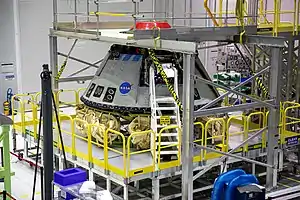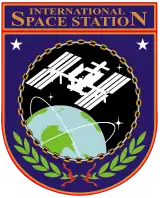Boeing Starliner-1
Boeing Starliner-1[2] is the first operational crewed mission of the Boeing Starliner to the International Space Station (ISS), and is planned to be the fourth orbital flight mission of the Starliner overall. It is scheduled for launch No Earlier Than (NET) December 2021 with a crew of four.[3] It will transport members of a future ISS Expedition to the ISS. This would only be the fourth U.S. spaceflight with a female commander, after STS-93, STS-114, and STS-120.
 Calypso being processed at Boeing's Commercial Crew and Cargo Processing Facility in January 2020 | |
| Mission type | Crewed mission to ISS |
|---|---|
| Operator | Boeing / NASA |
| Mission duration | 180 days (planned) |
| Spacecraft properties | |
| Spacecraft | Boeing Starliner |
| Manufacturer | Boeing |
| Launch mass | 13,000 kg (29,000 lb) |
| Crew | |
| Crew size | 4 |
| Members | |
| Start of mission | |
| Launch date | December 2021 [1] |
| Rocket | Atlas V N22 |
| Launch site | Cape Canaveral, SLC-41 |
| End of mission | |
| Landing date | NET 2022 |
| Orbital parameters | |
| Reference system | Geocentric orbit |
| Regime | Low Earth orbit |
| Inclination | 51.66° |
| Docking with ISS | |
| Docking port | Harmony forward or zenith |
| Time docked | 180 days (planned) |
Crew
As this marks the first operational flight of Starliner, a Russian cosmonaut is not expected to be on board as Roscosmos has stated they do not want to put Russian cosmonauts on either Starliner or Crew Dragon until they have flown successful Commercial Crew Program flights. The fourth seat is likely to be taken by an international partner (Japan, Canada, or European Space Agency) astronaut, as happened with SpaceX Crew-1, with JAXA astronaut Soichi Noguchi.[4][5]
| Position | Crew member | |
|---|---|---|
| Commander | Third spaceflight | |
| Pilot | First spaceflight | |
| Mission Specialist 1 | First spaceflight | |
| Mission Specialist 2 | TBA | |
Mission
This mission will be the first reuse of a Starliner spacecraft. The vehicle was initially flown as the first uncrewed Orbital Flight Test mission in December 2019. On 22 December 2019, commander Sunita Williams announced the name "Calypso" for the spacecraft.[6] Calypso will now be used for Boe-CFT as Spacecraft 2 is used for Starliner Orbital Flight Test-2.
Jeanette Epps was added to the Starliner-1 mission on 25 August 2020.[7]
References
- Foust, Jeff (28 August 2020). "NASA and Boeing outline schedule of Starliner test flights". SpaceNews. Retrieved 28 August 2020.
- "Commercial Crew Press Kit". nasa.gov. NASA.
 This article incorporates text from this source, which is in the public domain.
This article incorporates text from this source, which is in the public domain. - NASA Commercial Crew (28 August 2020). "Boeing's Starliner Makes Progress Ahead of Flight Test with Astronauts". NASA. Retrieved 29 August 2020.
 This article incorporates text from this source, which is in the public domain.
This article incorporates text from this source, which is in the public domain. - Heiney, Anna (25 August 2020). "NASA Astronaut Jeanette Epps Joins NASA's Boeing Starliner-1 Mission". blogs.nasa.gov. NASA. Retrieved 25 August 2020.
 This article incorporates text from this source, which is in the public domain.
This article incorporates text from this source, which is in the public domain. - Clark, Stephen (25 August 2020). "Boeing plans second Starliner test flight in December 2020 or January 2021". spaceflightnow.com. Spaceflight Now. Retrieved 26 August 2020.
- Williams, Sunita [@Astro_Suni] (22 December 2019). "Thanking two mission control personnel" (Tweet) – via Twitter.
 This article incorporates text from this source, which is in the public domain.
This article incorporates text from this source, which is in the public domain. - Boeing [@Boeing] (25 August 2020). "The Starliner team is adding a new NASA astronaut" (Tweet) – via Twitter.




